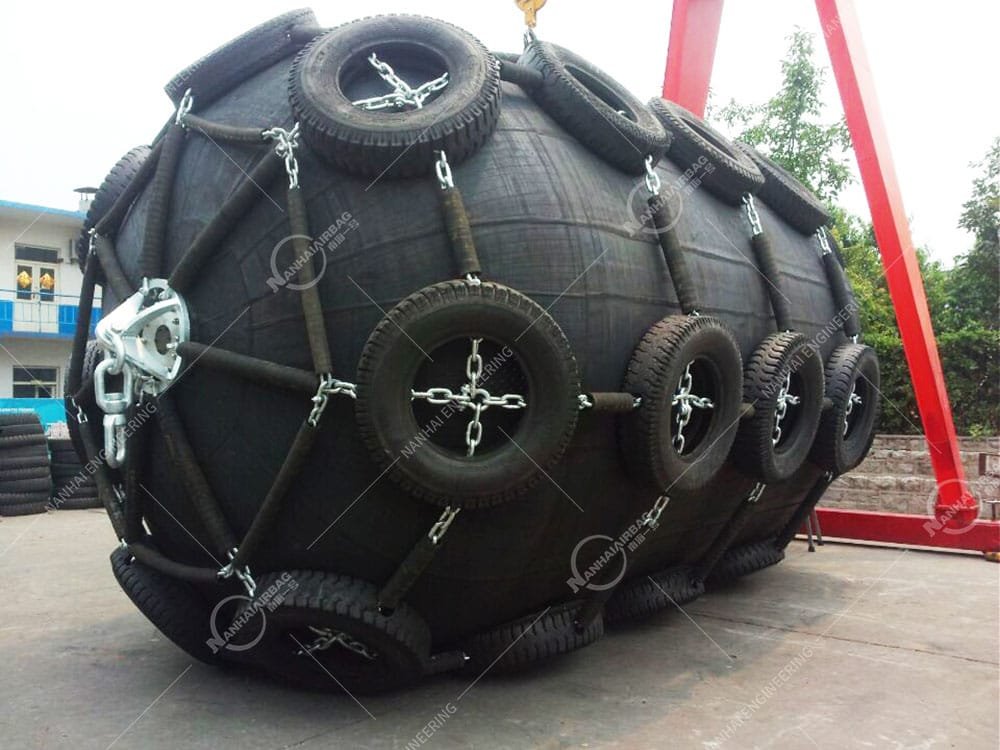Распространенные области применения крыльев для судов
02/21/2025Обслуживание и уход за морскими подушками безопасности
02/25/2025Преимущества пневматических крыльев Chain-Tyre

Chain Type Pneumatic Fenders
Increased Durability
The integration of chains and tyres into the fender design greatly enhances its overall durability and lifespan. The external chain-and-tyre net acts as a protective shield, preventing direct contact between the fender’s body and vessels or docks. This extra layer of protection minimizes the risk of punctures, cuts, and abrasions, even in environments where sharp edges and rough handling are common. As a result, chain-tyre pneumatic fenders maintain their structural integrity longer, ensuring reliable performance in demanding maritime operations.
Superior Shock Absorption
Chain-tyre pneumatic fenders are designed to provide outstanding energy absorption while minimizing the force transferred to the vessel and docking structures. The compressed air inside the fender acts as a cushion, effectively dispersing the energy generated during berthing. This makes them particularly ideal for busy ports, container terminals, and ship-to-ship operations, where large cargo vessels, tankers, and bulk carriers dock regularly. By reducing the impact force, they help protect both vessels and port facilities from costly damages.
Protection Against Heavy Impacts
Unlike traditional fender types, chain-tyre pneumatic fenders are specifically engineered to withstand extreme berthing forces. Their design enables them to absorb high levels of kinetic energy without deformation or failure, making them suitable for large-scale docking operations. Whether handling LNG carriers, oil tankers, or offshore support vessels, these fenders safeguard both the hull of the ship and the surrounding infrastructure, preventing structural damage and reducing downtime caused by repair work.

Cost-Effectiveness
Investing in chain-tyre pneumatic fenders delivers long-term cost savings for port authorities, shipping companies, and offshore operators. Their robust construction and superior resistance to wear significantly reduce the frequency of replacements, repairs, and maintenance. Moreover, their long service life ensures that the total cost of ownership remains lower compared to alternative fendering systems. For operators handling high-value cargo and frequent docking operations, this translates to better return on investment.
Resistance to Environmental Factors
Marine environments can be extremely harsh, but chain-tyre pneumatic fenders are built to withstand these challenges. The combination of reinforced rubber, chains, and tyres provides superior resistance against UV radiation, saltwater corrosion, oil exposure, and extreme temperature variations. Whether deployed in tropical climates, cold-weather regions, or offshore platforms, these fenders maintain consistent performance and reliability, ensuring uninterrupted port operations under any conditions.
Chain-Type Pneumatic Fenders Applications
One of the greatest strengths of chain-tyre pneumatic fenders is their versatility. They can be deployed in a wide variety of maritime environments, including:
- Commercial ports and container terminals
- Oil and LNG terminals
- Offshore platforms and floating structures
- Ship-to-ship (STS) transfer operations
- Naval and military applications
Their adaptability to different docking scenarios makes them a go-to solution for operators seeking high-performance fendering systems capable of supporting vessels of all sizes.
FAQs about Chain-Tyre Pneumatic Fenders
1. What are chain-tyre pneumatic fenders used for?
They are used to absorb berthing energy и protect vessels and docks during docking or ship-to-ship operations.
2. Why do these fenders have chains and tyres?
The chain-and-tyre net shields the fender body from cuts, abrasions, and impacts, extending its service life.
3. How long do they last?
With proper maintenance, they typically last 8–12 yearsДаже в суровых морских условиях.
4. Are they suitable for offshore applications?
Yes. They are widely used on offshore platforms и STS transfers due to their высокое поглощение энергии.
